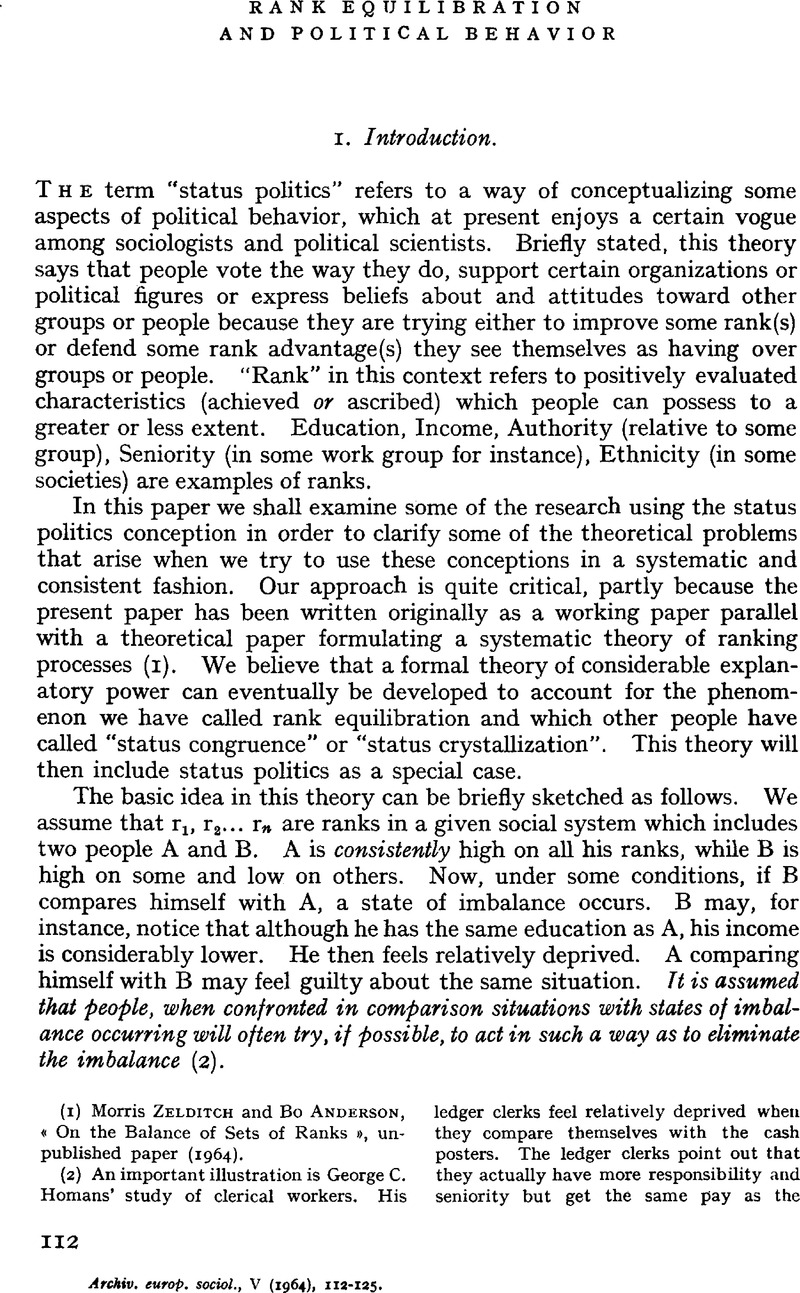Article contents
Rank Equilibration and Political Behavior
Published online by Cambridge University Press: 28 July 2009
Abstract

- Type
- Notes Critiques
- Information
- European Journal of Sociology / Archives Européennes de Sociologie , Volume 5 , Issue 1 , June 1964 , pp. 112 - 125
- Copyright
- Copyright © Archives Européenes de Sociology 1964
References
(1) Zelditch, Morris and Anderson, Bo, «On the Balance of Sets of Ranks», unpublished paper (1964).Google Scholar
(2) An important illustration is George C. Homans' study of clerical workers. His ledger clerks feel relatively deprived when they compare themselves with the cash posters. The ledger clerks point out that they actually have more responsibility and seniority but get the same pay as the cash posters. The conditions under which imbalance does not occur includes role differentiation. A welder in a plant, for instance, does not normally expect a manager to get less pay than himself although the manager usually is less competent at welding. This and other conditions are discussed in the theory paper. Cf. Homans, G. C., «La congruence du status», J. psych., LIV (1957), 22–34Google Scholar, and “Status among Clerical Workers”, Human Organization, XII (1953), 33–10.Google Scholar
(3) Lenski, Gerhard E., “Status-Crystallization: A Non-Vertical Dimension of Social Status”, A.S.R., XIX (1954), 405–413.Google Scholar
(4) Ibid. pp. 406 sqq.
(5) How the subjects were placed in each of these variables is described in Lenski. Ibid. pp. 407 sqq.
(6) Goffman, Irwin W., “Status Consistency and Preference for Change in Power Distribution”, A.S.R., XXII (1957), 33–281.Google Scholar
(7) See, for instance, Gans, Herbert J., “The Origin and Growth of a Jewish Community in the Suburbs: A Study of the Jews of Park Forest”, in Sklare, M. (ed.), The Jews, Social Patterns of an American Group (Glencoe, uThe Free Press, 1958), 205–248Google Scholar. See also Kramer, Judith R. and Leventman, Seymour, Children of the Gilded Ghetto: Conflict Resolutions of Three Generations of American Jews (New Haven, Yale University Press, 1961).Google Scholar
(8) Hofstadter, Richard, “The Pseudo-Conservative Revolt”Google Scholar, in Bell, D., The New American Right (New York, Criterion Books, 1955), 33–55.Google Scholar
(9) Bell, D., op. cit.Google Scholar
(10) Lockwood reports some British data on the attitudes of the clerks to the working class organization. “In a Gallup Poll (1956) roughly one out of every three clerks who were interviewed on the causes of recent strikes and on the policy of the government should take in this situation gave answers which clearly demonstrated movetheir conception of the working class and trade unionism as a threatening and dangerous force which should be repressed.” The Blackcoated Worker (London, Allen and Unwin, 1958), p. 104Google Scholar, footnote 2. Lockwood's entire chapter on the status problems of the British white collar workers contains many useful insights into status politics of the lower middle class in England. In his autobiography Ernst Wigforss, a Swedish socialist politician, gives excerpts from a letter containing a vivid eyewitness account of a meeting at which the Rev. Stöcker, a prominent leader in the pre-World War I antisemitic movement in Germany, spoke. Stöcker's speech blaming the Jews and the labor movement for all evils had a strong appeal among some lower middle class elements (Wigforss, Ernst, Minnen, 1914–1932, Vol. II (Stockholm, Tidens Förlag, 1951), pp. 27 sqq.)Google Scholar
(11) Lipset, Seymour M. and Bendix, Reinhard, Social Mobility in Industrial Society (Berkeley, University of California Press, 1960).Google Scholar
(12) This is Lipset's and Bendix' main thesis, but the data advanced to support it are far from satisfactory.
(13) , Harold L. and Edwards, Hugh, “The Skidder: Ideological Adjustments of Downward Mobile Workers”, A.S.R., XXIV (1959), 33–231.Google Scholar
(14) Maccoby, Eleanor E. et al. , “Youth and Political Change”, The Public Opinion Quarterly, XVIII (1954–1955), 23–39.CrossRefGoogle Scholar
(15) Anderson, Bo, “Some Problems of Change in the Swedish Electorate”, Acta sociologica, VI (1962), 33–255.Google Scholar
(16) Maccoby, , op. cit. pp. 23–29.Google Scholar
(17) Lipset, and Bendix, , op. cit. p. 67.Google Scholar
(18) Key, Valdimer O., Public Opinion and American Democracy (New York, Knopf, 1961), p. 146.Google Scholar
(19) Lipset, , op. cit. p. 67Google Scholar; Anderson, op. cit. pp. 241–255.Google Scholar
* We are much indebted to Adam Haber, Howard S. Becker, Christian Bay and Patricia Richmond for valuable comments on earlier versions of this paper.
- 7
- Cited by




